Samsung Q800T 8K QLED TV
The Samsung Q800T may be the cheapest 8K TV that Samsung is putting out this year, and therefore not the most highly specified, but its price point may be the best argument for getting an 8K television into your home.
That relatively lower price point is understandable considering the Q800T's is a bit of an older model at this point, and those that want something a little more feature-rich and up to date may want to check out the Q800T's successor, the QN800A, which added Mini LED backlighting for improved contrast and brightness control.
While Samsung is not alone in its conviction that 8K TVs are already worth buying, it’s certainly more aggressive than any other brand about turning that conviction into commercially-available products. We’ve already seen it combining 8K resolution with a cutting edge ‘bezel-free’ Infinity design with the Q950TS series.
Now, with the Q800T, Samsung is trying to make 8K more attractive financially, by selling it at the same £3,799 launch price as last year’s flagship Q90R 4K TV.
- New Samsung TV 2021: what's new this year?
Price and availability
The Q800T is Samsung’s cheapest 8K QLED model this year. It starts at $3,199 / £3,799 / AU$4,999 for the 65-inch model (reviewed here). There’s also a 75-inch model for $4,499 / £5,299 / AU$6,499, and an 82-inch model for $5,999 / £64,999 / AU$8,499.
Design
Screen sizes available: 65-inch, 75-inch, 82-inch | Tuner: Freeview HD | 4K: Yes | HDR: Yes (HDR10, HDR10+, HLG) | Panel Technology: Quantum Dot LED (QLED) | Smart TV: Eden | Curved: No | Dimensions: 1447.9(w) x 830.9(h) x 25.2(d)mm | 3D: No | Inputs: Four HDMIs, three USBs, RF tuner, Wi-Fi, Bluetooth, optical digital audio output, bluetooth headphone support
The Q800T isn’t as eye-poppingly attractive as Samsung’s ‘bezel-free’ Infinity screen flagship models. It also carries all of its connections on the main TV body, rather than shipping with one of Samsung’s external One Connect boxes. Naturally this makes cable management more of an issue.
Just because it’s not as attractive as the Q950TS, though, doesn’t mean the Q800T isn’t still easy on the eye. Its frame is trim, its flat rear gives it a crisp, monolithic feel, and its centrally mounted stand is robust and attractively finished. The stand is practical, too, since it lets you put the TV on a narrower piece of furniture than you can with separate feet instead.
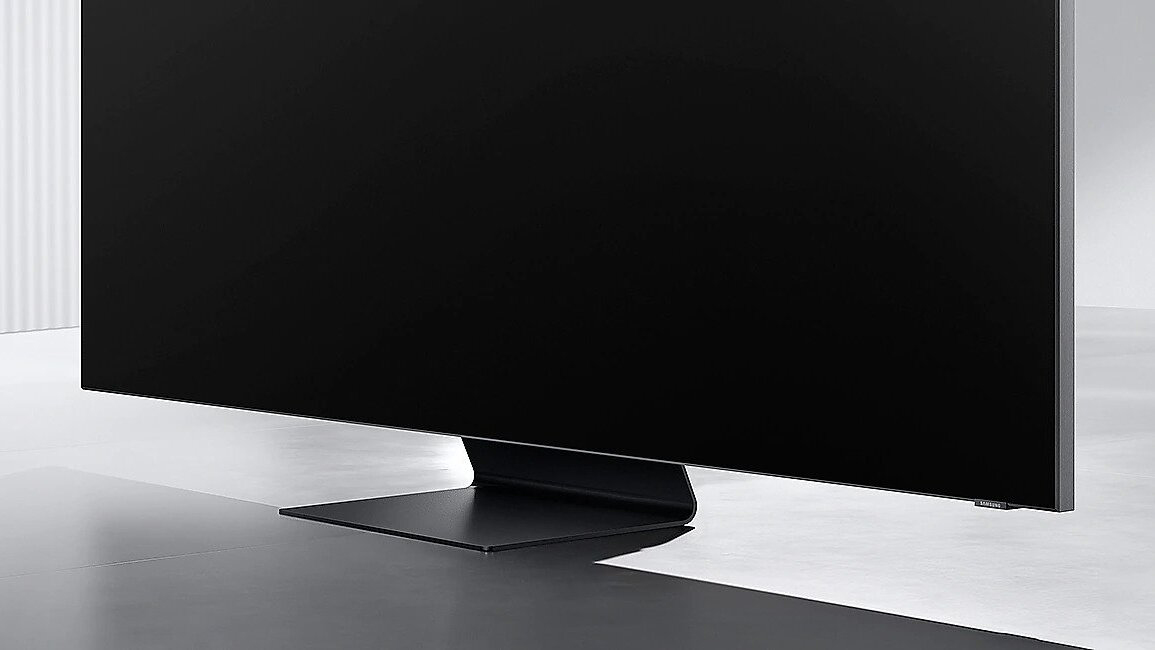
While its monolithic flat front/flat back design looks cool, the TV is quite a bit deeper round the back than many of today’s TVs. This is to be expected, though, from a TV that sports a direct LED lighting engine, where the LEDs sit behind the screen rather than around its edges.
As usual with premium Samsung TVs, the Q800T ships with two remotes. One is a fairly straightforward button-filled affair. The other is a small, sleek, metallic alternative with a vastly stripped down button count and a mic button for accessing the TV’s voice recognition features.
Turning finally to the Q800T’s connections, its provision of four HDMIs, three USBs and Wi-Fi and Bluetooth network options is as we would expect. One of the HDMIs supports both 8K at 60Hz and 4K at 120Hz, too – both of which could come in handy with the upcoming new generation of games consoles. Given there will be two of these consoles, though – not to mention a new generation of gaming PCs – it seems odd that Samsung has only provided one high bandwidth HDMI 2.1 port.
Design TL;DR: Although it ditches Samsung’s trademark external One Connect box, the 65Q800T is still a cool and industrial hunk of premium TV design.
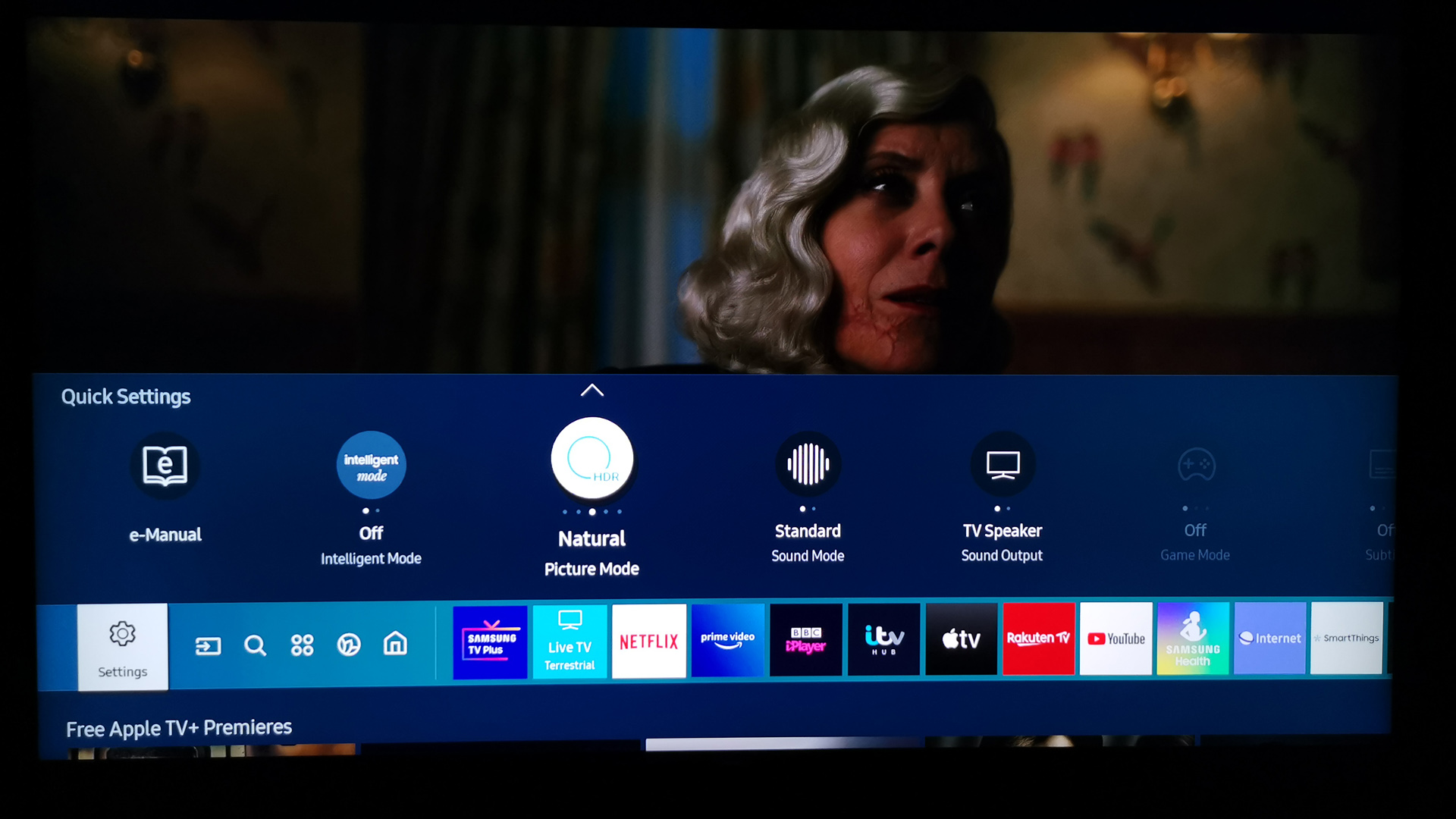
Smart TV (Tizen)
The Q800T uses Samsung’s Tizen-based Eden smart TV platform. For the most part this is a good thing. The main interface is very economical in terms of the amount of screen space it occupies, and yet can still get you easily to plenty of content without you having to delve into too many submenus.
You can easily customise the running order of the scrolling bar of apps along the bottom edge, so that your favourites appear first. And it’s also easy to add more apps from Samsung’s app store.
Samsung is also to be praised for supporting a wide range of key apps. These include all the catch-up services for the main terrestrial broadcasters, Netflix, YouTube, Amazon Prime Video, Disney Plus, and Apple TV Plus.
The only thing missing from Samsung’s app roster is Freeview Play. This UK service brings together all the key terrestrial broadcaster catch up apps into one nicely presented place, and makes hunting down shows you might have missed easier than having to work through lots of different individual apps.
The Q800T’s apps provide 4K and HDR where a platform supports them. You even get HDR10+ support with Amazon, meaning the HDR streams carry extra scene-by-scene data to help compatible TVs deliver better pictures.
The Q800T does not, though, support Dolby Vision. This, like HDR10+, provides extra scene-by-scene picture information you don’t get with the basic HDR10 HDR system. And it’s actually more widely available than HDR10+, both on streaming platforms such as Disney Plus and Netflix, and on 4K Blu-ray discs.
Finally, it’s nice to see Samsung building in support for more voice control systems this year. So as well as Samsung’s own Bixby platform, the Q800T will support both Amazon Alexa and, following a future firmware update, Google Assistant.
Smart features TL;DR: Samsung provides a content-rich, easy to use and customise smart system only let down in the UK by its lack of Freeview Play support.
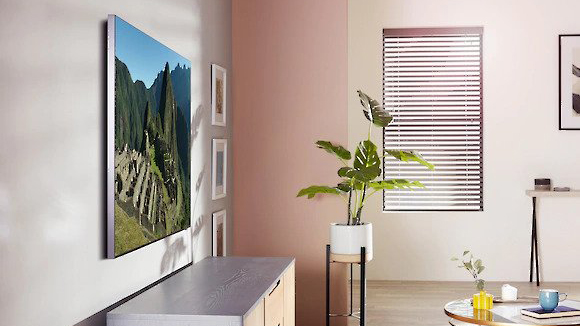
HD/SDR performance
Samsung has introduced a new ‘deep learning’ component to its AI picture processing for 2020 that’s allowed it to build a much more massive and effective database of picture knowledge it can apply to its upscaling of sub-8K sources.
The results are jaw-droppingly apparent even with HD sources. The effectiveness with which Samsung’s new entry-level 8K set adds 31 million extra pixels to HD images while simultaneously eliminating source noise is phenomenal. Provided you avoid the rather tepid Movie preset, at least, the upscaled HD images look vastly more detailed and dense than they do in their standard HD form on an HD screen. In fact, they look more detailed and dense than they do on most 4K TVs – and than they did on Samsung’s 2019 8K TVs.
This upscaling improvement is critical of course, given that for the foreseeable future viewers will find themselves watching HD sources on even an 8K TV much more than they’ll find themselves watching native 8K.
Samsung no longer provides a standard dynamic range to high dynamic range conversion system on its TVs. But it arguably doesn’t need to, as its Standard and Dynamic presets are both capable of delivering SDR content with plenty of punch and dynamism without making them look unnatural or forced.
The Movie mode also provides purists with a relatively subdued, decently ‘accurate’ image, while the Natural picture preset offers a pretty effective halfway house between the Movie mode’s accuracy and the other punchier presets.
Contributing to the set’s impressive SDR efforts is an outstanding black level performance that makes it easy to forget that you’re watching an LCD TV. This is down to a combination of the screen’s ‘full array with local dimming’ (FALD) lighting set up, and Samsung’s new contrast-boosting power redistribution system, which shares power around the dimming zones more efficiently.
There’s pretty much no trace of the usual LED issues of backlight clouding or haloing around bright objects, either. Even in the black bars above and below the picture.
Having such inky blacks to bounce off helps the Q800T deliver rich-looking SDR colours, and its powerful processing and ample brightness ensures that there’s a wealth of nuance within those colour tones.
There are a couple of caveats to the Q800T’s mostly superb HD/SDR efforts. First, the screen dims down bright objects a touch when they appear against a dark backdrop, in a bid to keep distracting areas of clouding at bay. Second, the non-Movie picture presets can cause a little black crush in shady corners – especially with the Natural preset.
HD/SDR performance TL;DR: Fantastic AI-driven upscaling does a better job of converting HD to 8K than you’d think possible, and contrast and colour are both beautiful.
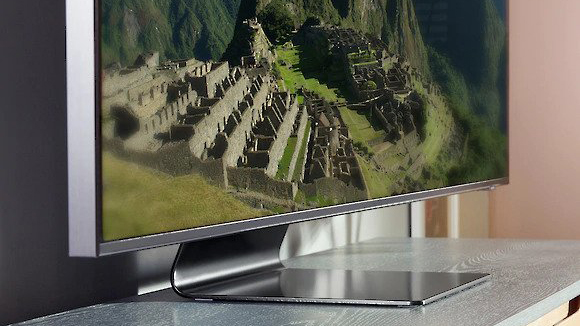
4K/HDR performance
With a claimed peak brightness of 2000 nits that it more or less measures up to – at least for short ‘bursts’ – the Q800T is ready, willing and able to get tons of impact and real-life dynamism from HDR images. At least where those HDR images are pretty uniformly bright.
Also, because the Q800T can go so much brighter than most TVs, it holds on to more detail than most rivals in the brightest parts of aggressive HDR content – including movies mastered to 4000 nit peaks – without sacrificing overall brightness levels.
The 65Q800T retains startlingly deep black levels with HDR content too, despite HDR’s much-expanded brightness range. This is especially impressive when you consider that the local dimming only has 224 zones to work with rather than the 480 zones used in previous Samsung 8K TVs.
The Q800T’s upscaling comes up trumps again with 4K content. As with HD sources, upscaled 4K looks considerably sharper and more textured looking than it did on Samsung’s 2019 8K TVs. So much so, actually, that it’s no surprise to discover that Samsung has tweaked the sub-pixel-based wide viewing angle technology it introduced last year to ensure it doesn’t have as much of an impact on perceived resolution.
This does mean that the Q800T can’t be watched from as wide an angle as Samsung’s 2019’s 8K sets before black levels and colour response diminish. But given that the main attraction of an 8K TV is surely its resolution, Samsung’s tweak to the viewing angle/resolution balance seems entirely sensible.
Again, the results of the Q800T’s upscaling of 4K looks strikingly natural, due to the processor’s deep learning-enhanced ability to distinguish between source noise and real source picture information, before figuring out the look of the new pixels it’s having to create.
It’s particularly good to see Samsung not falling into its old habit of over-sharpening upscaled images using its default preset settings to the point where they become gritty and harsh.
Watching 4K (and 8K) sources made it easy to appreciate the Q800T’s impressive motion handling. Even without using any of the TV’s available motion processing options, camera pans and fast-moving objects look detailed, sharp, and free of excessive judder. However, using the custom motion setting (no higher than level four) lets you take the edge off what little judder or blur there is, without 24fps images starting to look processed, messy or unnaturally smooth.
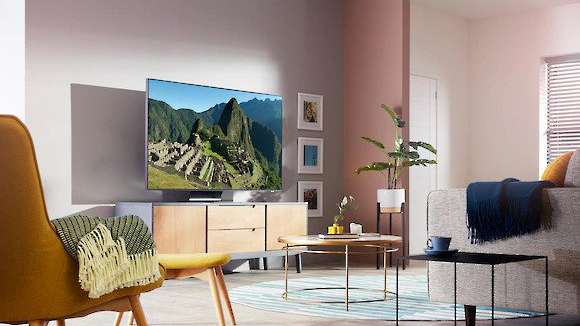
Colours are a little hit and miss. On the down side they’re not as richly saturated and vibrant as those of some other Samsung TVs – including 2020’s 4K flagship Q95T and last year’s Q90R.
For the most part, the Q800T’s colours look more natural than the more heavily saturated tones of those other 4K Samsung models. The 8K models’ improved processing means colours also enjoy slightly more refinement.
The Q800T’s picture attributes are particularly well suited to its Movie preset, without the flat black levels and yellowy colour tones that have tended to accompany previous generations of Samsung Movie mode.
Although it will be many moons before you’ll be watching much native 8K content, it should look outright spectacular when it eventually arrives on the 65Q800T. With our 8K test footage – predominantly nature scenes mastered by picture testing gurus Spears & Munsil – it consistently looked gorgeous, delivering in abundance the remarkable textures, sense of three-dimensional depth and uncanny directness and naturalism that define the 8K experience. Its 8K pictures are noticeably sharper and just more ‘8K’ than those of Samsung’s 2019 models.
The Q800T also excels in some ways as a gaming monitor. Its input lag, for instance, is remarkably low, at barely 10ms with the Game picture preset. Also cool are features for calling in a touch of motion smoothing processing at the cost of only a few extra ms of lag, and raising the brightness of dark areas to make it easier to spot lurking enemies.
The screen’s brightness and contrast work well with game graphics too. The only issue is that the amount of picture processing and control Samsung has to turn off to hit the Game mode’s low input lag figure does reduce picture quality. That’s especially noticeable when it comes to black level and general backlight control. So unless you’re playing a particularly reaction-based game, you might prefer to use a tweaked non-Game picture preset instead.
The Q800T’s other issue is that it dims bright HDR objects that appear against a dark backdrop very aggressively at times, in its bid to avoid backlight ‘blooming’. So much so that small bright objects against near-black backdrops can start to actually look quite dull. The dimming is markedly less aggressive with the Movie picture preset active – though the trade off is that dark areas look greyer.
Feeding the TV an HDR10+ source marginally improves the dimming situation, too (reminding me that it’s a shame there isn’t also any Dolby Vision support). Finally, it’s important to stress that the sort of extreme contrast content that causes the most distractingly heavy dimming on the 65Q800T seldom appears with normal TV viewing, and typically only crops up occasionally even during movies.
4K/HDR TL;DR: Outstanding 8K upscaling, bags of brightness and some seriously impressive black levels make the Q800T a typically spectacular 4K HDR performer. The local dimming system can occasionally be very aggressive, though.
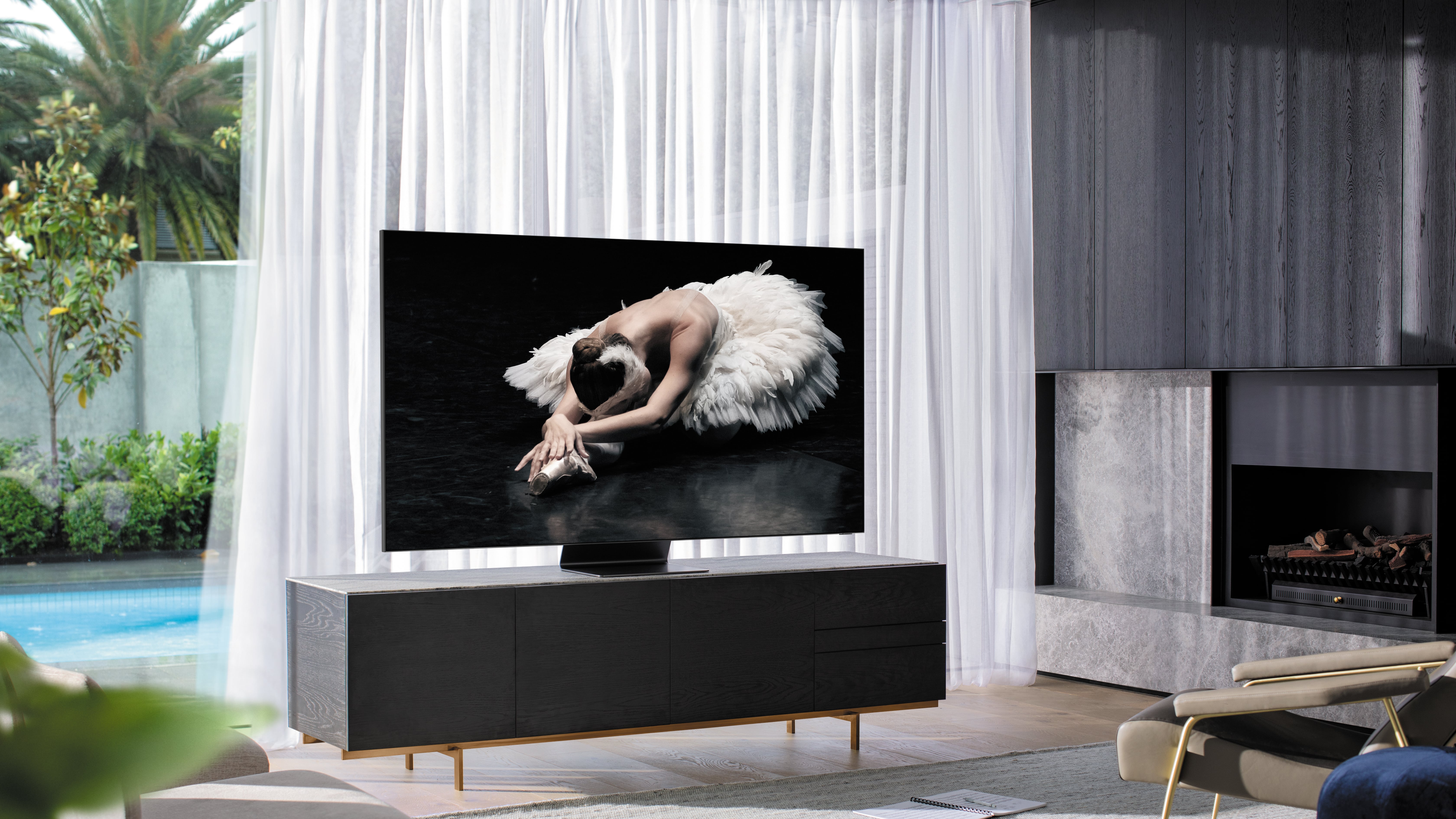
Audio performance
Samsung has come up with a striking new sound feature for its premium 2020 TVs: Object Tracking Sound. As its name suggests, this uses speakers built around the TV frame and clever processing to make sounds appear to emanate from the correct part of the screen.
The Q800T deploys the most advanced form of Object Tracking Sound: OTS+. This comprises a 4.2.2-channel speaker system firing sound from the top, sides and bottom edges of the screen – and the results are very impressive.
The sound really does track the onscreen imagery uncannily well. Even better, it tracks sound off the screen, too. So if a car travels beyond the edge of the screen but still appears on the soundtrack, you will hear the car continue to more away from the side of the screen it disappeared past.
The sound is powerful enough to deliver a large, cohesive soundstage, and propels the sound with much more forward impact than TVs typically do. The mid-range is open and clear, too, and there’s a healthy amount of bass to underscore action scenes. All in all, OTS+ works superbly – especially considering this is the system’s debut year.
Sound performance TL;DR: Powerful, dynamic, room-filling sound combined with some almost uncannily accurate effects placement.
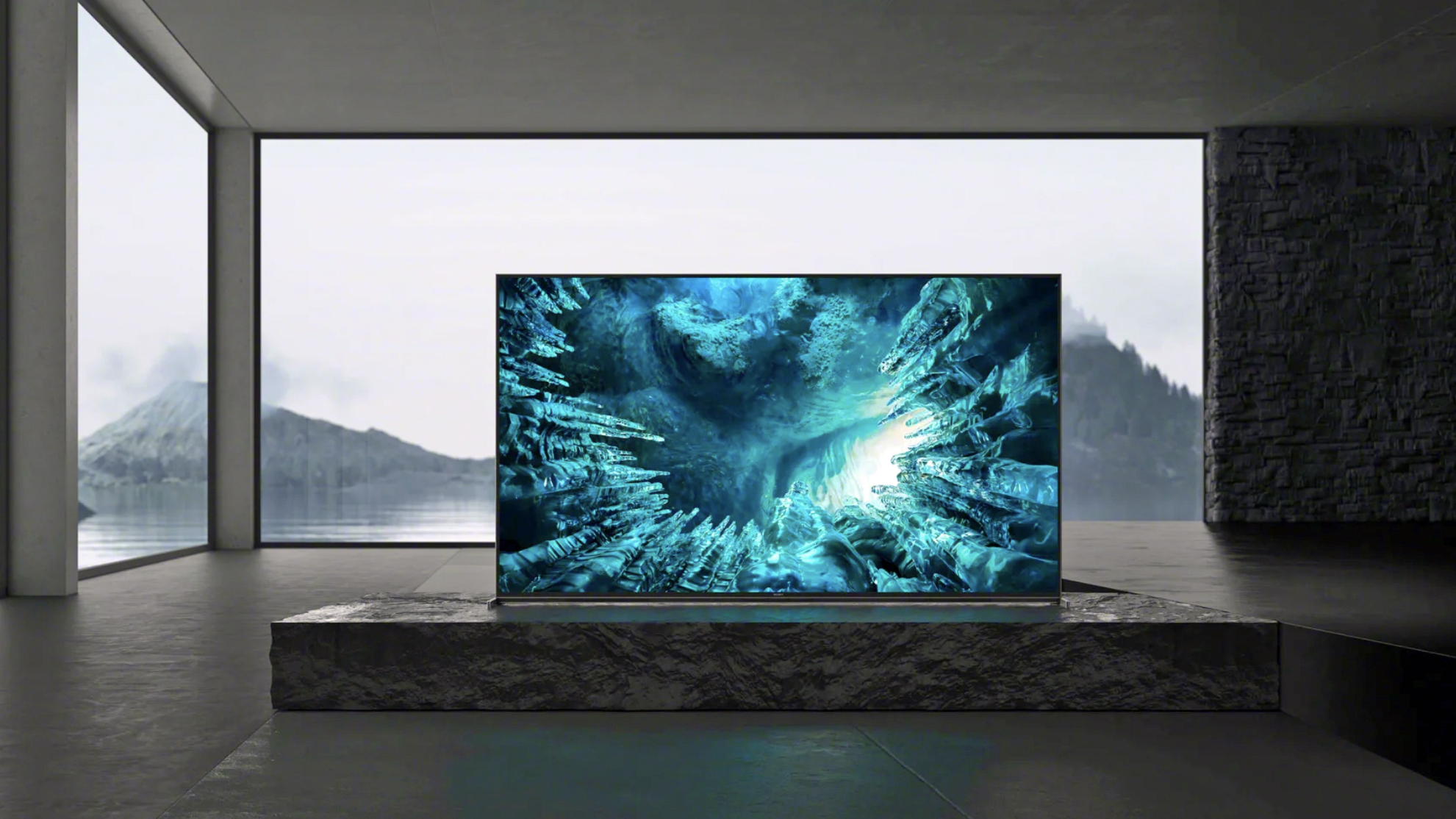
Other screens to consider
If you can live without the 8K resolution and don’t mind dropping to 120 local dimming zones, Samsung’s 4K Q95T delivers startlingly good, contrast-rich pictures for a whole £1,000 less at a 65-inch size. The Q95T models ship with an external connections box too, so that only a single slim cable has to run into the screen.
On the downside, while the 65Q95T sports object tracking sound, this is delivered using a smaller number of speakers and less power. And resolution isn’t quite as high, obviously, as it is with this 8K TV.
Another 4K option that offers excellent picture quality for £1,000 less than the 65-inch Q800T is LG’s CX OLED. This uses OLED rather than LCD picture technology, meaning that while it can’t get as bright as the Samsung 8K set, its local contrast works superb as a home cinema screen. Just remember that you have to handle OLED with care to avoid image retention.
There isn’t really anything else 8K out there in the 65Q800T’s price range. Samsung’s own stellar 75-inch Q950TS delivers 10 inches more screen, a good upgrade in picture quality and a beautiful ‘frameless’ design – but costs an eye-watering $12,999 / £7,999 / AU$12,099. Sony’s new 75-inch ZH8 8K TV might also be interesting thanks to Sony’s X1 Ultimate processor, but still costs $5,999 / £5,999.
Verdict
The Samsung Q800T is the first 8K TV you can buy for something at least approaching a 4K TV price, which makes it a standout new Samsung TV for 2020.
The price-conscious sacrifices Samsung has had to make to its backlight system inevitably impact its performance during dark scenes versus Samsung’s phenomenal flagship 8K TVs. But the Q800T remains a frequently spectacular watch that still makes its 8K difference count, even with non-8K content.
- Best Samsung TV: our top QLED picks
0 comments:
Post a Comment